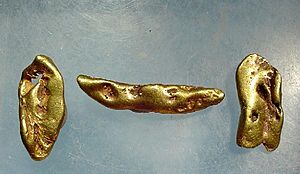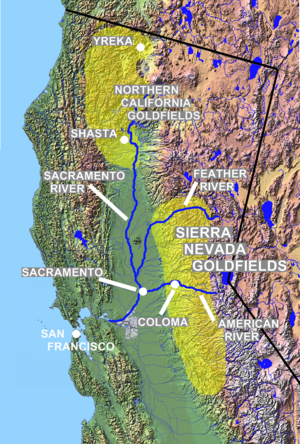Gold in California facts for kids

Gold became very concentrated in California, United States, thanks to amazing natural processes that happened over hundreds of millions of years. Volcanoes, moving land plates, and even erosion (like wind and water wearing away rocks) all worked together to gather huge amounts of gold in California's mountains. During the California Gold Rush, gold-seekers known as "Forty-Niners" found this gold. They started with simple ways to find it, then invented clever new methods that were later used all over the world.
How Gold Got There: Geology

For over 400 million years, tiny bits of gold spread out in the Earth's crust slowly gathered together in California. Only when gold is gathered in one place is it easy enough to find and dig up. About 400 million years ago, the rocks that would become California were at the bottom of a large sea. Underwater volcanoes erupted, adding lava and minerals (like gold) to the seafloor. Sometimes, enough material built up to create islands.
Between 400 million and 200 million years ago, the seafloor and these volcanic islands moved eastward. They crashed into the North American plate, which was moving westward.
Around 200 million years ago, the moving tectonic plates forced the seafloor to slide underneath the North American continent. As it sank, or subducted, deep below the western edge of the continent, parts of the seafloor and the land above it got very hot and melted. This created large pools of molten rock, called magma.
Because this magma was lighter and hotter than the old rock above it, it pushed its way upward. As it rose, it cooled down and turned into the granite rock you can see in the Sierra Nevada mountains and other California mountains today. As the hot magma cooled and hardened, gold became concentrated within watery silica solutions. This gold was then deposited inside veins of quartz rock.
As the Sierra Nevada and other California mountains were pushed up by the moving tectonic plates, the hardened minerals and rocks were brought closer to the surface. Then, erosion began to wear them down. The surrounding rock crumbled, and the exposed gold and other materials were carried downstream by water. Gold is much heavier than most other minerals, so this process helped to gather the gold even more. Pockets of gold collected in quiet, gravelly spots along the sides of old rivers and streams.
The California mountains rose and shifted several times over the last 50 million years. Each time, old streambeds moved and dried out, leaving behind the gold deposits in ancient gravel beds. Newer rivers and streams then formed, and some of these cut through the old channels, carrying the gold into even larger concentrations.
The Forty-Niners of the California Gold Rush first looked for these gold deposits, which had been collected in the gravel beds by millions of years of geological activity.
Finding and Recovering Gold
Because the gold in California's gravel beds was so rich, the early Forty-Niners simply used pans to find gold in the rivers and streams. However, panning is slow. So, clever miners and groups of miners started using "cradles," "rockers," or "long-toms" to process much larger amounts of gravel.
Miners also used a method called "coyoteing." This involved digging a shaft about 6 to 13 meters (20 to 40 feet) deep into the gravel deposits along a stream. Then, they dug tunnels in all directions from the bottom of the shaft to find the richest areas of gold-bearing dirt.
For bigger projects, groups of prospectors would even change the path of an entire river. They would dig a sluice (a channel) alongside the river to divert the water. This exposed the river bottom, allowing them to dig for gold there. Experts estimate that about 12 million ounces (370 metric tons) of gold were found in the first five years of the Gold Rush.
Later, by 1853, a new method called hydraulic mining was used. This involved using a high-pressure hose to spray a powerful stream of water at old gold-bearing gravel beds on hillsides. The water would wash away the loosened gravel and gold, which then flowed over sluices. The heavy gold would settle to the bottom and be collected. By the mid-1880s, it's thought that 11 million ounces (340 metric tons) of gold had been found this way. This method of hydraulic mining later spread around the world.
One problem with these methods was that large amounts of gravel, silt, and other materials went into streams and rivers. Even today, many areas still show the marks of hydraulic mining, as the exposed earth and gravel deposits often don't support plant life.
After the main Gold Rush ended, people continued to look for gold. The next step was to find gold that had slowly washed down into the flat river bottoms and sandbars of California's Central Valley and other gold areas. By the late 1890s, dredging technology (also invented in California) became popular. It's estimated that more than 20 million ounces (620 metric tons) of gold were found by dredging.
During the Gold Rush and in the years that followed, gold-seekers also did "hard-rock" mining. This meant digging the gold directly out of the rock that contained it, usually quartz. Miners would dig and use blasts to follow and remove veins of gold-bearing quartz. Once the gold-bearing rocks were brought to the surface, they were crushed. The gold was then separated, either by washing it in water (since gold is heavier than quartz sand) or by washing the sand over copper plates coated with mercury. Gold forms a mixture called an amalgam with mercury. Losing mercury during this process caused some environmental pollution.
Eventually, hard-rock mining became the biggest source of gold in the Gold Country. The total amount of gold found in California from then until now is estimated to be 118 million ounces (3,700 metric tons).
Geological After-effects
For decades before the 1906 San Francisco earthquake, there were many small earthquakes in Northern California. Scientists used to think these were signs that the big 1906 earthquake was coming. However, it was later discovered that these smaller earthquakes happened more often during certain seasons. This was because of the large amounts of sand and dirt that flowed into coastal bays from gold mining inland. This extra weight on the land above the faults (cracks in the Earth's crust) caused the ground to shake more.


